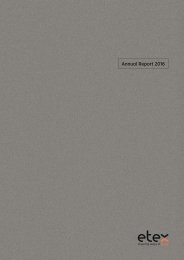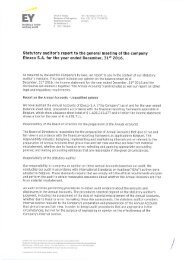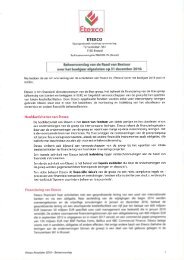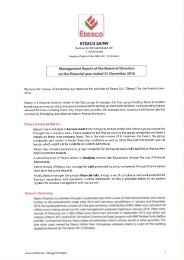ETX-10829_Etex-AR2017_WEB_2018_DEF2 (2)
Create successful ePaper yourself
Turn your PDF publications into a flip-book with our unique Google optimized e-Paper software.
6.1<br />
Financial report<br />
Consolidated financial statements<br />
<strong>Etex</strong> Annual Report 2017<br />
Financial report<br />
Consolidated financial statements<br />
accounting estimates by changing the amortisation charge for the current and future periods. The amortisation expense is recognised in<br />
the income statement in the expense category consistent with the function of the asset.<br />
C - Goodwill<br />
Goodwill represents the excess of the cost of a business combination over the Group’s interest in the net fair value of the identifiable<br />
assets, liabilities and contingent liabilities of a subsidiary, equity accounted investees or joint venture at the date of acquisition. Goodwill<br />
on acquisitions of equity accounted investee or joint ventures is included in the carrying amount of the investments. Goodwill on the<br />
acquisition of subsidiaries is presented separately, and is stated at cost less accumulated impairment losses (see Note E).<br />
If the Group’s interest in the net fair value of the identifiable assets, liabilities and contingent liabilities exceeds the cost of the business<br />
combination, this excess (frequently referred to as negative goodwill or badwill) is immediately recognised in the profit and loss<br />
statement, after a reassessment of the fair values.<br />
Additional investments in subsidiaries in which the Company already has control are accounted for as equity transactions; any premium<br />
or discount on subsequent purchases of shares from minority interest are recognised directly in the Company’s shareholders equity.<br />
D - Investment property<br />
Investment property is property held to earn rental income or for capital appreciation or for both and is valued at acquisition cost less<br />
accumulated depreciation and impairment losses. The carrying amount includes the cost of replacing part of an existing investment<br />
property at the time that cost is incurred if the recognition criteria are met. Investment property is depreciated similar to owned property<br />
(see Note A).<br />
Investment properties are derecognised when either they have been disposed of or when the investment property is permanently<br />
withdrawn from use and no future economic benefit is expected from its disposal. Any gains or losses on the retirement or disposal of an<br />
investment property are recognised in the income statement in the year of retirement or disposal.<br />
Transfers are made to investment property when there is a change in use, evidenced by ending of owner-occupation, commencement of<br />
an operating lease to another party or ending of construction or development. Transfers are made from investment property when there is<br />
a change in use, evidenced by commencement of owner-occupation.<br />
E - Impairment of assets<br />
At each reporting date, the Group assesses whether there is any indication that an asset, other than inventories and deferred taxes, may<br />
be impaired. If any such indication exists, the recoverable amount of the asset (being the higher of its fair value less costs to sell and its<br />
value in use) is estimated. In assessing the value in use, the estimated future cash flows are discounted to their present value using a<br />
pre-tax discount rate that reflects the current market assessments of the time value of money and the risks specific to the asset. Where it<br />
is not possible to estimate the recoverable amount of an individual asset, the Group estimates the recoverable amount of the smallest<br />
cash-generating unit to which the asset belongs. If the recoverable amount of an asset or cash-generating unit is estimated to be less<br />
than its carrying amount, the carrying amount of the asset or cash-generating unit is reduced to its recoverable amount. Impairment<br />
losses are recognised in the income statement. Where an impairment loss subsequently reverses, the carrying amount of the asset or<br />
cash-generating unit is increased to the revised estimate of its recoverable amount. That increased amount cannot exceed the carrying<br />
amount that would have been determined had no impairment loss been recognised for that asset or cash-generating unit in prior periods.<br />
A reversal of an impairment loss is recognised immediately in the income statement apart from goodwill for which no such reversal is<br />
allowed.<br />
the gain or loss on disposal of the operation. Goodwill disposed of in this circumstance is measured based on the relative values of the<br />
operation disposed of and the portion of the cash-generating unit retained.<br />
Financial assets: When a decline in the fair value of an available-for-sale financial asset has been recognised directly in<br />
comprehensive income and there is objective evidence that the asset is impaired, the cumulative loss that has been recognised directly<br />
in comprehensive income is recognised in the income statement even though the financial asset has not been derecognised. The amount<br />
of the cumulative loss that is recognised in the income statement is the difference between the acquisition cost and the current fair value,<br />
less any impairment loss on that financial asset previously recognised in the income statement. The reversal of an impairment loss in<br />
respect of an investment in an equity instrument classified as available-for-sale, following an event occurring after the recognition of the<br />
impairment loss, is performed in comprehensive income. In the case of equity investments classified as available-for-sale, objective<br />
evidence would include a significant or prolonged decline in fair value of the investment below its cost.<br />
F - Investments in debt and equity securities<br />
All purchases and sales of investments are recognised on trade date, which is the date that the Group commits to purchase or sell the<br />
asset.<br />
Investments in equity securities are undertakings in which the Group does not have significant influence or control. These investments<br />
are designated as available-for-sale financial assets, as they are not held for trading purposes. At initial recognition they are measured at<br />
fair value unless the fair value cannot be measured reliably in which case they are measured at cost. The fair value is determined by<br />
reference to their quoted bid price at reporting date. Subsequent changes in fair value, except those related to impairment losses which<br />
are recognised in the income statement, are recognised directly in comprehensive income. On disposal of an investment, the cumulative<br />
gain or loss previously recognised in comprehensive income is recognised in the income statement.<br />
G - Government grants<br />
Government grants are recognised where there is reasonable assurance that the grant will be received and all attaching conditions will<br />
be complied with. When the grant relates to an asset, the grant value is recognised as a deferred income and is released to the income<br />
statement as a reduction of the depreciation charge over the expected useful life of the relevant asset by equal annual instalments. When<br />
the grant relates to a compensation of an expense, it is recognised as income over the period necessary to match the grant on a<br />
systematic basis to the costs incurred.<br />
Government grants that are expected to be released within twelve months after the reporting date are classified as other current<br />
liabilities. The other government grants are classified as non-current liabilities.<br />
Intangible assets with indefinite useful lives and intangible assets that are not yet available for use are tested for impairment annually<br />
either individually or at the cash-generating unit level. The useful life of an intangible asset with an indefinite life is reviewed annually to<br />
determine whether the indefinite life assessment continues to be adequate. If not, the change in the useful life assessment from indefinite<br />
to finite is made on a prospective basis.<br />
Goodwill is tested annually for impairment, or more frequently if events or changes in circumstances indicate that the carrying value<br />
may be impaired. For the purpose of impairment testing, goodwill acquired in a business combination is, from the acquisition date,<br />
allocated to each of the Group’s cash-generating units, or groups of cash-generating units, that are expected to benefit from the<br />
synergies of the combination.<br />
Impairment is determined by assessing the recoverable amount of the cash-generating unit (or group of cash-generating units) to which<br />
the goodwill relates. Where the recoverable amount of the cash-generating unit (or group of cash-generating units) is less than the<br />
carrying amount, an impairment loss is recognised.<br />
Where goodwill forms part of a cash-generating unit (or group of cash-generating units) and part of the operation within that unit is<br />
disposed of, the goodwill associated with the operation disposed of is included in the carrying amount of the operation when determining<br />
<strong>Etex</strong> Annual Report 2017 p. 11<br />
<strong>Etex</strong> Annual Report 2017 p. 12<br />
106 107
















